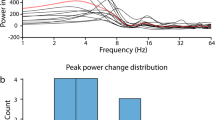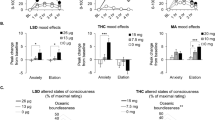Abstract
The present study investigated the effects of three centrally acting drugs on the significant increase in the intermediate alpha frequency of the electroencephalogram (EEG) that accompanied meditation in a male volunteer. When compared to the EEG recorded before each of the three drugs was administered, naloxone tended to enhance the increase in the power of the intermediate alpha EEG (9.4–10.4 Hz), while diazepam tended to spread the increase to the slow (7.4–9.4 Hz) alpha EEG, and flumazenil was without much effect on the overall EEG pattern. However, these EEG changes when compared to similar changes obtained with saline administration were not significantly different from the latter. Thus, it is unlikely that the EEG correlates of meditation are causally related to the rise or fall of endogenous opioid peptides or benzodiazepinelike substances in the brain.
Similar content being viewed by others
References
Allison, J. (1970). Respiratory changes during transcendental meditation.Lancet, 1 833–834.
Banquet, J.-P. (1973). Spectral analysis of the EEG in meditation.Electroencephalography and Clinical Neurophysiology, 35 143–151.
Benson, H. (1975).The relaxation response New York: William Morrow and Company.
Gellhorn, E., & Keily, W. F. (1972). Mystical states of consciousness: Neurophysiological and clinical aspects.Journal of Nervous & Mental Diseases, 154 399–405.
Jasper, H. (1958). Report of the committee on methods of clinical examination in electroencephalography.Electroencephalography and Clinical neurology, 270–375.
Jerome, H. J., & Martin, R. W. (1991). Chapter 21, Opioid analgesics and antagonists, in Goodman & Gilman (Eds.),The pharmacological basis of therapeutics. New York: Pergamon Press.
Orme-Johnson, D. W. (1973). Autonomic stability and transcendental meditation.Psychosomatic Medicine, 35 341–349.
Rall, T. W. (1991). Chapter 17, Hypnotics and sedatives; ethanol, in Goodman & Gilman (Eds.),The pharmacological basis of therapeutics. New York: Pergamon Press.
Saito, M., Sim, M. K., & Suitzu, N. (1983). Acupuncture-evoked EEG of normal human subjects.American Journal of Acupuncture, 11 225–229.
Sim, M. K., Saito, M., & Suitzu, N. (1983). Constancy of frequency distribution in normal EEG taken under different visual states.Neurosciences, 9 171–176.
Wallace, R. K. (1970). Physiological effects of transcendental meditation,Science, 167 1751–1754.
Author information
Authors and Affiliations
Additional information
This research was supported by a grant from the Singapore Turf Club (STC 4837). The authors would like to thank the subject for volunteering as a subject in this study; and Ms. Chua Mui Eng for her technical assistance.
Rights and permissions
About this article
Cite this article
Sim, M.K., Tsoi, W.F. The effects of centrally acting drugs on the EEG correlates of meditation. Biofeedback and Self-Regulation 17, 215–220 (1992). https://doi.org/10.1007/BF01000404
Issue Date:
DOI: https://doi.org/10.1007/BF01000404




